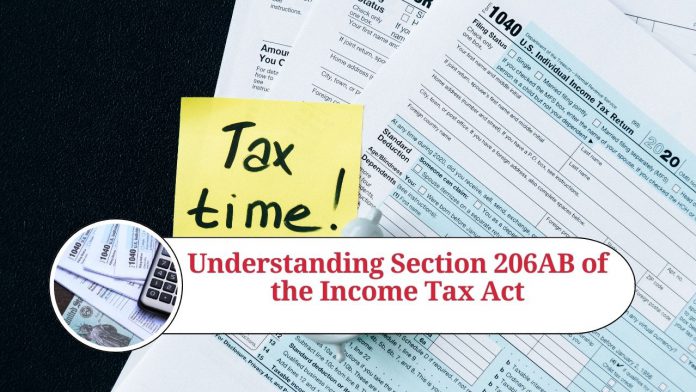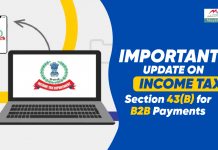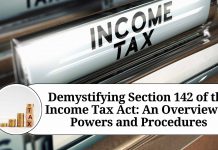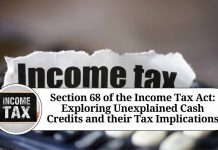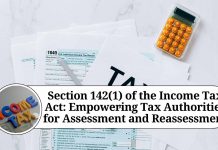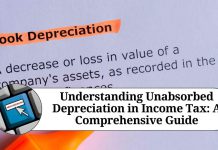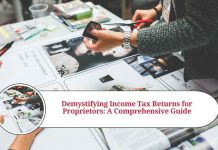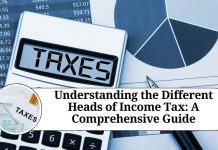Section 206AB of the Income Tax Act was introduced by the Finance Act, 2021, and it deals with the deduction of tax at source (TDS) for certain non-compliant taxpayers. The section aims to increase tax compliance and reduce tax evasion by providing for higher TDS rates for those taxpayers who have not filed their tax returns or have not paid their taxes on time.
Under this section, the tax deductor is required to deduct tax at a higher rate of 5% (twice the normal rate or the rate specified in the relevant provisions of the Act) for certain specified transactions, such as payment of salary, interest, dividend, rent, and so on, to the non-compliant taxpayers. This higher rate of TDS will be applicable for a period of two years from the date of non-compliance, or until the taxpayer becomes compliant, whichever is earlier.
Who is a non-compliant taxpayer under Section 206AB?
A non-compliant taxpayer is defined as an individual, Hindu Undivided Family (HUF), Association of Persons (AOP), Body of Individuals (BOI), Firm, or Company who has not filed the income tax return for the preceding two assessment years, and for which the due date of filing has expired and the aggregate of tax deducted at source and tax collected at source is Rs. 50,000 or more in each of these two years.
In addition, a non-compliant taxpayer is also defined as one who has not filed the income tax return for the preceding two assessment years, and for which the due date of filing has expired and the aggregate of the amount of deemed total income under section 115BBE of the Act and the tax deducted at source is Rs. 50,000 or more in each of these two years.
Exceptions to Section 206AB
There are certain exceptions to this section. The provisions of Section 206AB shall not apply in the following cases:
- Where the tax deductor is the Central Government, State Government, or any local authority.
- Where the tax deductor is a statutory body, institution, or authority established by or under any Central, State, or Provincial Act, or a public sector company.
- Where the tax deductor is an individual or HUF, and the transaction does not require deduction of tax at source under the provisions of the Act.
- Where the tax deductor is not required to obtain Tax Deduction and Collection Account Number (TAN) under the provisions of the Act.
Higher TDS rates under Section 206AB
Under Section 206AB, the tax deductor is required to deduct tax at a higher rate of 5% or twice the normal rate, whichever is higher. The normal rate of TDS is usually specified in the relevant provisions of the Act, and it varies depending on the type of transaction and the status of the taxpayer.
For example, if the normal rate of TDS for interest payments to a resident individual is 10%, the tax deductor will have to deduct tax at a higher rate of 20% (twice the normal rate) if the recipient is a non-compliant taxpayer.
However, if the normal rate of TDS for a particular transaction is already 5% or higher, then the tax deductor will have to deduct tax at the normal rate itself. In such cases, the higher TDS rate specified under Section 206AB will not apply.
Effective date of Section 206AB
Section 206AB of the Income Tax Act came into effect from July 1, 2021. This means that the higher TDS rates specified under this section will apply to transactions made on or after July 1, 2021.
The section also applies to transactions that are ongoing as of July 1, 2021, but where the TDS has not been made or has been made at a lower rate. In such cases, the tax deductor will have to deduct tax at the higher rate specified under Section 206AB for the remaining period of two years from the date of non-compliance.
Impact of Section 206AB
Section 206AB is expected to have a significant impact on tax compliance and revenue collection in India. By imposing higher TDS rates for non-compliant taxpayers, the section aims to encourage timely filing of tax returns and payment of taxes.
This is particularly relevant in the case of small taxpayers, who may have been previously hesitant to file their tax returns or pay their taxes due to various reasons such as lack of awareness, financial constraints, or difficulty in complying with the complex tax laws.
However, it is important to note that Section 206AB is only one of the many measures being taken by the government to improve tax compliance and reduce tax evasion. Taxpayers are still expected to comply with all other tax provisions and requirements, and failure to do so may result in penalties and legal consequences.
Read more useful content:
- section 234e of income tax act
- section 286 of income tax act
- section 90a of income tax act
- section 40a(7) of income tax act
- section 226(3) of income tax act
- section 24 of income tax act
Frequently Asked Questions (FAQs)
Q: What is Section 206AB of the Income Tax Act?
A: Section 206AB is a provision introduced in the Income Tax Act, which provides for higher TDS rates for certain non-compliant taxpayers.
Q: Who is considered a non-compliant taxpayer under Section 206AB?
A: A non-compliant taxpayer is defined as an individual, HUF, AOP, BOI, Firm, or Company who has not filed the income tax return for the preceding two assessment years, and for which the due date of filing has expired and the aggregate of TDS and TCS is Rs. 50,000 or more in each of these two years.
Q: What is the higher TDS rate specified under Section 206AB?
A: The tax deductor is required to deduct tax at a higher rate of 5% or twice the normal rate, whichever is higher, for certain specified transactions, such as payment of salary, interest, dividend, rent, etc.
Q: When did Section 206AB come into effect?
A: Section 206AB of the Income Tax Act came into effect from July 1, 2021.
Q: Are there any exceptions to Section 206AB?
A: Yes, there are certain exceptions to this section. The provisions of Section 206AB shall not apply in the case of Central Government, State Government, local authority, statutory body, institution, or authority established by or under any Central, State, or Provincial Act, or a public sector company. It also does not apply to individuals or HUFs where the transaction does not require deduction of tax at source.
Q: What is the period for which the higher TDS rates will be applicable under Section 206AB?
A: The higher TDS rates specified under Section 206AB will be applicable for a period of two years from the date of non-compliance, or until the taxpayer becomes compliant, whichever is earlier.
Q: Can a non-compliant taxpayer avoid the higher TDS rates under Section 206AB?
A: Yes, a non-compliant taxpayer can avoid the higher TDS rates by filing their income tax returns for the preceding two assessment years and ensuring timely payment of taxes. Once the taxpayer becomes compliant, the higher TDS rates specified under Section 206AB will no longer be applicable.

